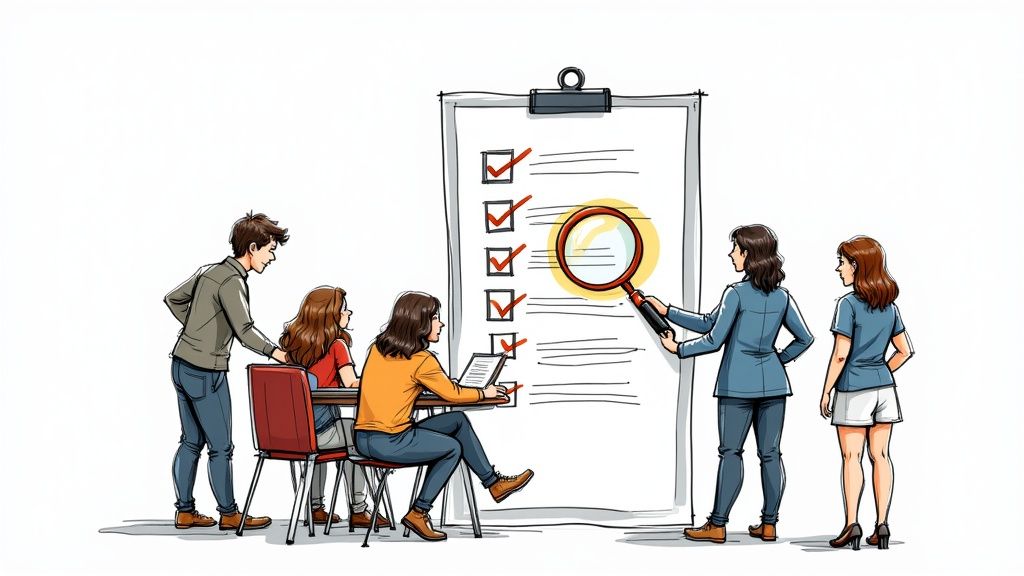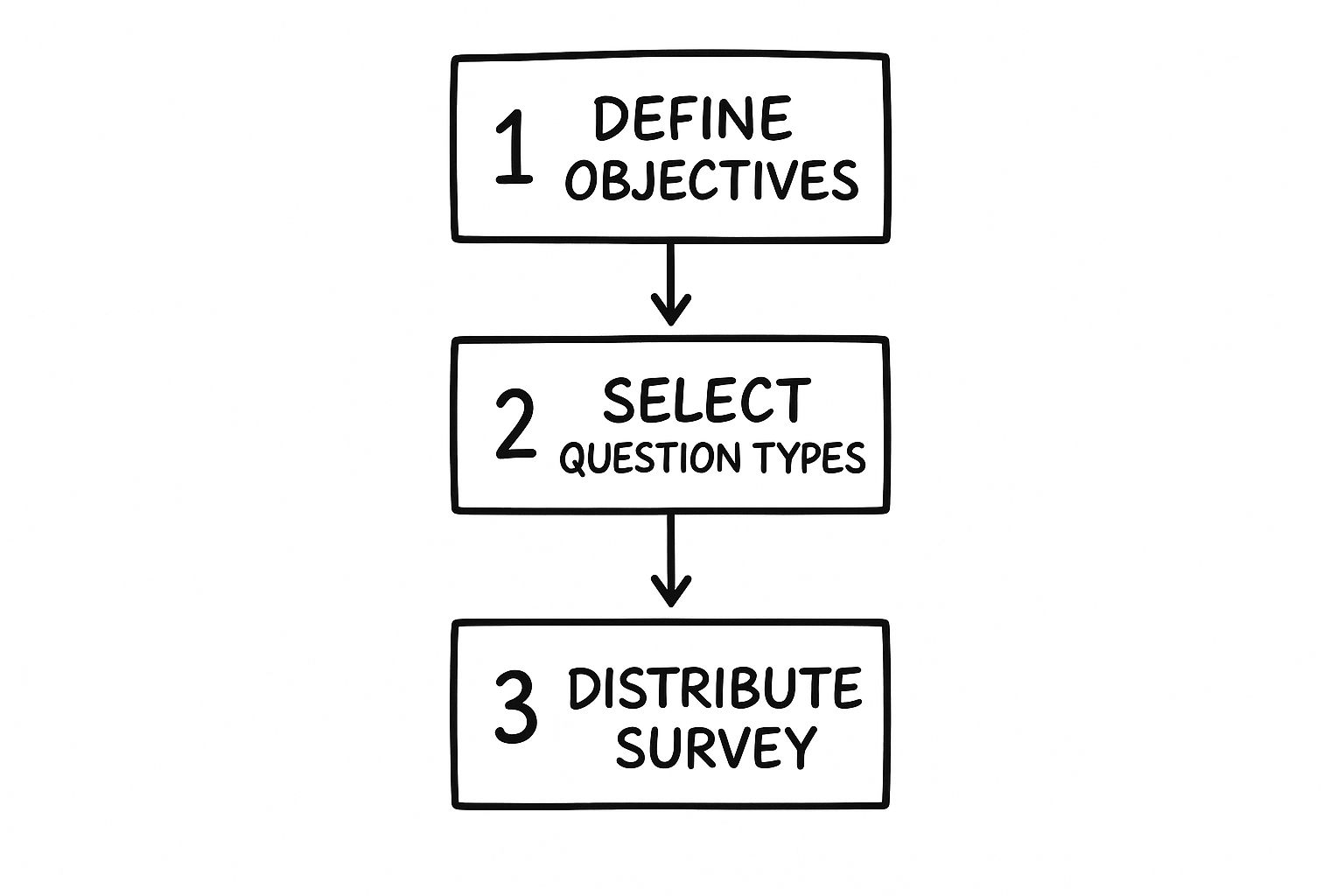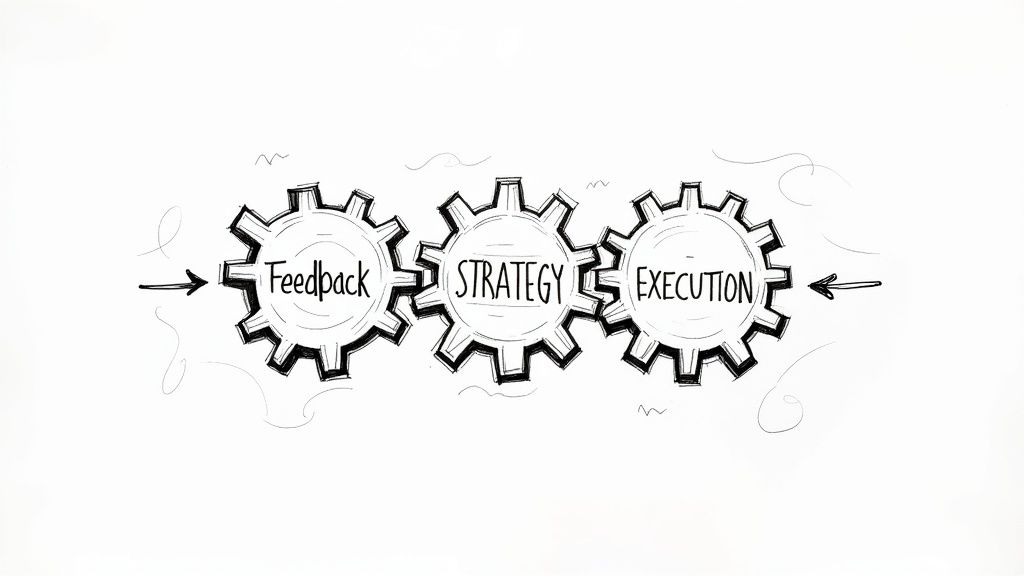Mastering the Organizational Culture Survey

An organizational culture survey is far more than just a questionnaire; it's a diagnostic tool that gets to the heart of your company's work environment. It’s how you measure and truly understand the shared values, beliefs, behaviors, and attitudes that define the day-to-day reality for your team. Think of it as a data-backed window into the dynamics that influence everything from employee engagement to your bottom-line business performance.
Your Guide to Understanding Workplace Culture

Let's be honest, a culture survey can sometimes feel like just another task on a long HR to-do list. But what if you started seeing it as your most powerful tool for understanding what’s really happening inside your company? This isn't about a simple happiness poll. It’s about uncovering the hidden, often unspoken, dynamics that impact performance every single day.
A well-crafted survey gives you a clear, data-backed view of the values and behaviors actually driving your organization. More importantly, it shines a light on the gap between the culture you think you have and the one your employees genuinely experience.
Why Culture Surveys Are More Than Just a Check-the-Box Exercise
Ignoring the undercurrents of your workplace culture is a huge risk. The data doesn't lie: according to a seminal study by Gallup, companies in the top quartile of employee engagement outperform their peers by 147% in earnings per share. This demonstrates a straight line from a healthy culture to a healthy bottom line.
It’s also a magnet for top talent. A 2024 LinkedIn report revealed that 73% of job seekers want to work for companies that are transparent about their workplace culture. This makes a culture assessment a critical tool for both keeping your best people and attracting new ones.
An organizational culture survey is a snapshot in time of how your employees feel about different programmatic elements of your culture. It’s crucial to measure periodically to see how you are improving long-term.
The Real-World Impact of Cultural Insights
A culture survey can expose critical disconnects. For instance, your leadership team might genuinely believe the company fosters open communication. But what if the survey results show that employees in a specific department feel unheard or are afraid to speak up? That’s not just a data point; it’s an actionable insight you can work with.
Understanding these nuances is the first step toward building a more resilient, engaged, and productive workforce. But getting it right involves more than just sending out questions. Following a complete organizational culture assessment guide for modern companies can give you a structured approach to make sure your efforts are effective.
For a deeper dive into gauging team sentiment, you can also consult a comprehensive employee morale survey guide. Ultimately, taking a proactive approach to understanding and shaping your culture is no longer a "nice-to-have"—it's an essential business strategy.
Designing a Survey That People Actually Complete
Let's be honest: the difference between a culture survey that gets ignored and one that actually sparks change comes down to design. If you just grab a generic template, you'll get generic, uninspired answers. The real magic is in the art of writing great questions and building a tool that pulls out honest, actionable insights from your team.
This isn't just about making a list of questions. It's a thoughtful process. You have to make sure you're measuring what truly matters and, just as importantly, making people want to participate.
Start with Clear Objectives, Not Just Questions
Before you even think about writing a question, you need to know why you're doing this. What's the goal?
Are you trying to gauge psychological safety after a big reorg? Maybe you need to get a real read on trust in leadership. Or perhaps the goal is to figure out why cross-team collaboration feels so clunky.
Without a sharp focus, your survey becomes a random collection of questions, and the data you get back will be a confusing mess. Setting clear, specific objectives from the outset ensures every single question serves a strategic purpose.
This visual really nails the foundational flow—you have to start with strategy before you get into the tactics of question writing and distribution.

Choosing the Right Question Formats
The types of questions you use will make or break the quality of your feedback. Most of the time, you'll be working with two main formats: Likert scales and open-ended questions. Each has its own strengths.
Likert Scale Questions: These are your classic "rate your agreement" scales (e.g., from "Strongly Disagree" to "Strongly Agree"). They are fantastic for gathering quantitative data that you can easily track and benchmark over time. Think of questions like, "I feel comfortable sharing my opinions, even when they differ from others on my team."
Open-Ended Questions: These are your "why" and "how" questions. They invite detailed, qualitative feedback and can uncover the specific stories and nuances a rating scale will always miss. For instance: "What is one thing we could do to improve collaboration between departments?"
The most powerful surveys use a smart mix of both. The Likert scales give you the "what"—the hard numbers. The open-ended questions give you the "why"—the human context behind those numbers.
The table below illustrates some key cultural dimensions you might want to measure and shows how different question formats can help you get the insights you need.
Key Cultural Dimensions and Sample Question Types
| Cultural Dimension | What It Measures | Effective Question Type (Example) |
|---|---|---|
| Psychological Safety | The level of comfort employees feel in speaking up, taking risks, and being vulnerable. | Likert Scale: "I feel safe to take a risk on this team, even if I might fail." |
| Leadership Trust | Confidence in the integrity, competence, and intentions of senior leadership. | Open-Ended: "What is one thing our leadership team could start doing to build more trust?" |
| Collaboration | How effectively teams and departments work together toward common goals. | Likert Scale: "When I need help from another department, I know who to ask and get a timely response." |
| Inclusion & Belonging | The extent to which all employees feel valued, respected, and able to be their authentic selves. | Open-Ended: "Can you describe a time when you felt you truly belonged at this company?" |
| Growth & Development | Perceptions of opportunities for career progression and skill-building. | Likert Scale: "I see a clear path for my career growth at this organization." |
By structuring your survey around core dimensions like these, you move beyond simple satisfaction scores to a much deeper understanding of your organizational DNA.
Crafting Questions That Elicit Honest Answers
How you word your questions is everything. One poorly worded question can skew your results and undermine the entire effort. I've seen it happen time and time again.
Here are a few common pitfalls to sidestep:
Corporate Jargon: Ditch the buzzwords and acronyms. A question like, "How would you rate our cross-functional synergy initiatives?" will just confuse people. Instead, ask, "How well do teams from different departments work together on projects?" Simple. Clear.
Leading Questions: Don't bake the answer into the question. Asking, "Don't you agree that our new wellness program is a great success?" is just fishing for compliments. A much better, more neutral question is, "How has the new wellness program impacted your well-being at work?"
Double-Barreled Questions: Make sure each question asks only one thing. A classic mistake is something like, "Are you satisfied with your pay and your opportunities for career growth?" You have no idea which part the person is answering. Split it into two separate questions to get clean data.
Key takeaway: Clear, neutral, and single-focus questions are the foundation of reliable feedback. Your goal is to uncover the truth, not just to confirm what you already think you know.
This same principle of neutrality is vital in other areas of HR. For example, when you're trying to make hiring fairer, you need to focus on objective evidence, which is why there's a growing interest in reducing hiring bias with evidence-based tools.
Don’t Forget About Distribution and Accessibility
Finally, how you get the survey into your employees' hands matters—a lot. If it's a pain to access or complete, your participation rates will plummet. You have to make it dead simple.
Meet your people where they already are. Many teams live in Slack all day, so it makes sense to deliver the survey there. Innovative approaches, like using user risk surveys conducted via Slack, show how integrating into existing workflows can dramatically boost engagement.
Think of your culture survey as your opportunity to listen at scale. When you design it with clear goals, a smart mix of questions, and genuine respect for your employees' time, you create something that people will not only complete but will also trust as a real effort to make the workplace better for everyone.
How to Maximize Your Survey Participation Rate

Let's be honest. You can design the most brilliant culture survey in the world, but it means nothing if your team doesn't actually take it. Low response rates are more than just a data problem; they're a red flag, often pointing to deeper issues with trust or engagement.
Getting people to participate—and participate thoughtfully—is an art. It requires a strategy that goes far beyond just sending out a mass email and hoping for the best. Your real goal is to build momentum and make employees feel like they have a genuine stake in the process, not just another box to check.
Build a Communication Plan That Inspires Trust
One of the biggest mistakes is the "one-and-done" email announcement. A much better way is to roll out a sequence of communications that builds anticipation and proactively answers the questions your team will inevitably have. People need to understand the why behind the survey.
A huge part of this is getting your managers on board as champions. They're on the front lines, and their endorsement is crucial. Arm them with a simple toolkit to make their lives easier:
- Key Talking Points: A few clear, simple messages they can share during team huddles.
- FAQs: Ready-to-go answers for common questions about anonymity, the survey's purpose, and the timeline.
- A Clear Schedule: Let them know exactly when communications are going out and when the survey opens and closes.
When leaders are visibly and vocally advocating for the survey, it sends a powerful message. This direct involvement turns managers into a powerful force for change, making your eventual action plans that much more effective.
The Non-Negotiable Guarantee of Anonymity
Anonymity isn't just a nice-to-have; it's the bedrock of honest feedback. If your employees, especially the skeptical ones, even have a whiff of fear that their answers can be traced back to them, you can forget about getting candid responses.
You have to do more than just promise anonymity—you have to prove it. Explain how you're protecting their identities. Tell them feedback is aggregated and that you only look at results in groups large enough to make individual identification impossible. That level of transparency is essential for overcoming the biggest hurdle to participation.
A sobering statistic from research firm Gartner indicates that one in three employees see organizational surveys as a 'waste of time' if they don't see any changes come from them. Guaranteeing anonymity is step one, but committing to action is what builds lasting trust.
This commitment to creating a safe space for feedback is also vital when you need to better manage cultural differences in the workplace, as it fosters the psychological safety required for any real dialogue.
A Practical Timeline for Maximum Engagement
Timing is everything. A well-paced communication schedule builds momentum without creating "survey fatigue." It's a strategic exercise, not just a to-do list.
Here’s a timeline that has proven effective:
1. The Heads-Up (1 Week Before Launch) Start creating some buzz. Announce the upcoming culture survey in an all-hands meeting, drop a note in the company newsletter, and have managers mention it in their team meetings. Explain the purpose, hammer home the confidentiality piece, and let everyone know why their voice matters.
2. Launch Day This is it. Send the official launch email with a clear, direct link and a firm deadline. Make sure this email comes from a respected senior leader to show just how important this initiative is to the company.
3. The Mid-Point Nudge (Halfway to Deadline) Send a gentle reminder to those who haven't responded yet. It's also a great opportunity to thank everyone who has already participated. Reiterate the "why" and keep the energy positive.
4. The Final Push (24-48 Hours Before Deadline) A final, friendly nudge can work wonders for boosting last-minute responses. Frame it as a "last chance to make your voice heard." You'll be surprised how many people were waiting for that last reminder.
This structured approach respects your team's time while keeping the survey top-of-mind. It shows them their input is genuinely valued, setting the stage not just for great participation, but for a more engaged culture long after the survey is done.
Finding the Real Story Within Your Survey Data
Once the survey closes, the real work begins. You're staring at a mountain of raw data—spreadsheets packed with numbers and pages of open-ended comments. It can feel daunting, but this is where the gold is hidden. Your mission is to transform this raw information into a clear, compelling story that gets leadership’s attention and sparks real change.
The goal isn't just to report the scores; it's to uncover the "why" behind them. Why did one department score so low on collaboration? What's the real story behind all those comments about communication? This is how you move from simply having data to truly diagnosing your company's cultural health.
Slicing the Data to Find Hidden Nuances
Looking at the overall company score is a decent starting point, but it barely scratches the surface. The real magic happens when you start segmenting the quantitative data. By slicing the results in different ways, you can pinpoint specific areas of strength and concern that get completely lost in the company-wide average.
This process is often called demographic segmentation, and it's all about filtering results by different employee groups to compare their experiences.
Here are some of the most insightful ways to do this:
- By Department or Team: This is often the most revealing cut. You might find that the Marketing team feels incredibly supported by their managers, while the Engineering team feels the exact opposite. Suddenly, you know it's a localized leadership issue, not a company-wide problem.
- By Tenure: How do new hires (less than a year) feel compared to your veterans (over five years)? Big differences here can point to issues with your onboarding process or a lack of long-term career pathing that's frustrating your loyal employees.
- By Location or Office: For companies with multiple sites or a mix of in-office and remote workers, this is essential. You can uncover major disparities in resources, communication styles, or feelings of inclusion between different work environments.
- By Role or Level: Do individual contributors see psychological safety differently than senior leaders do? Segmenting by hierarchy can expose a critical—and often invisible—disconnect between leadership's perception and the reality on the ground.
This kind of segmentation turns a vague problem into a specific, solvable one. An overall score of 7/10 on "opportunities for growth" becomes far more actionable when you see it's actually 9/10 for senior staff but a dismal 4/10 for junior employees. Now you know exactly where to focus.
Decoding the Voice of Your Employees
Your qualitative data—all those open-ended comments—is a goldmine. While the numbers tell you what people are feeling, the comments tell you why. The big challenge, of course, is making sense of hundreds or even thousands of individual remarks. This is where a process called thematic analysis comes in handy.
Thematic analysis is just a methodical way to identify and report the patterns, or "themes," running through all that text. Instead of getting bogged down in every single comment, you start grouping them based on the underlying idea.
Thematic analysis isn’t about counting keywords. It's about understanding the sentiment and context behind the words to build a rich, nuanced picture of the employee experience.
For instance, you might notice dozens of comments mentioning "meetings," "emails," and "project updates." Instead of treating these as three separate buckets, you could create a broader theme called "Communication Breakdowns." Under that, you might even have sub-themes like "Lack of Clarity from Leadership" or "Inefficient Cross-Team Updates." This approach helps you see the bigger picture and get to the root of the problem.
Sidestepping Common Analysis Traps
As you dig into the results, it’s incredibly easy to fall into mental traps that can skew your interpretation. Just being aware of these biases is the first step toward creating an honest and accurate report.
Two of the most common pitfalls are:
- Confirmation Bias: This is our natural tendency to hunt for data that proves what we already believe. If you went in thinking the company has a great culture, you might unconsciously focus on the positive comments and explain away the negative ones. To fight this, you have to actively look for disconfirming evidence and give every piece of feedback equal weight.
- Dismissing Negative Feedback: It's tempting to write off critical comments as outliers or the work of "a few complainers." Don't. That negative feedback is often your most valuable data. It points directly to your biggest opportunities for improvement. Treat every comment as a valid data point representing someone's genuine experience.
The stakes for getting this right are high. Recent statistics from Gallup paint a challenging picture, showing that globally, only 23% of employees are engaged at work. This disengagement is frequently tied directly to cultural issues like poor leadership and a lack of growth opportunities—exactly the kind of problems a thorough survey analysis can uncover. You can explore more about these trends by checking out the latest shocking workplace culture stats.
By approaching your data with a structured method and an open mind, you can build an honest, complete picture of your organization’s culture. For a deeper dive into making sense of your findings, check out our guide on understanding culture assessment results with data-driven insights. This is the foundation for creating an action plan that will truly make a difference.
How to Turn Your Survey Insights Into Action

This is where the rubber meets the road. Running a culture survey and digging through the data is one thing. But translating those numbers into real, tangible change? That's the part where many well-intentioned efforts fall apart. A solid action plan is what separates a genuine effort from a hollow exercise.
Let's be blunt: failing to act is worse than not asking at all. When your team invests their time and honesty into giving you feedback, they have a reasonable expectation that something will come of it. Ignoring their input is the quickest way to kill trust and guarantee they won't bother participating next time.
Presenting Findings That Inspire Action, Not Defensiveness
Before you can rally the troops, you need to get leadership on board. How you present the survey results to your executive team is everything. Your goal isn't to hand them a report card of failures; it's to show them a roadmap for growth.
Start with the data, but don't just leave it there. Tell the story behind the numbers. Instead of a flat "Collaboration scored low," try something with more context: "The data points to a major opportunity to improve how our teams work together, especially between engineering and product. We're seeing this friction impact project timelines."
Always remember to balance the tough stuff with the wins. Celebrating what the organization is already doing well creates goodwill and makes the critical feedback easier to swallow. Frame the whole discussion around the shared goal of making the company an even better place to work.
Run Action-Planning Workshops to Empower Ownership
A top-down mandate for change rarely sticks. The most powerful and lasting improvements bubble up from within the teams themselves. This is where action-planning workshops become your secret weapon.
After you've shared the company-wide results, give each manager their team-specific report. Then, bring them together for a facilitated workshop. The agenda is simple but effective:
- Dig Into Their Results: Help them understand their team’s unique profile of strengths and challenges.
- Brainstorm Real Solutions: Get them talking about the why behind their scores and thinking up practical fixes.
- Commit to a Plan: Guide them to choose just one or two high-impact initiatives they can realistically own and implement in the next quarter.
This approach gives managers a real sense of ownership. It transforms them from passive recipients of data into active drivers of cultural improvement, with solutions that actually fit their team's context.
A critical insight from Ethisphere’s research on the World’s Most Ethical Companies reveals that 76% of these top-tier organizations share culture survey results directly with all people leaders. They know that managers are the key to turning data into meaningful action.
Focus on a Few High-Impact Initiatives
One of the most common mistakes is trying to fix everything at once. When you present leaders with a dozen different "areas for improvement," you're inviting analysis paralysis. They get overwhelmed, and nothing gets done.
The solution is ruthless prioritization. Comb through your data and identify the two or three themes that are having the biggest, most widespread impact on your employee experience.
When deciding what to tackle first, ask yourself:
- Impact: Which issues are affecting the most people or creating the biggest drag on engagement?
- Feasibility: What can we realistically accomplish in the next 6-12 months with the resources we have?
- Alignment: Which initiatives will also help us hit our broader business goals for the year?
Focusing on a few key areas creates clarity and builds momentum. Nail one or two things, deliver a tangible win, and you’ll build the credibility and energy you need to tackle the next challenge.
Close the Loop and Communicate the Plan
Finally, and this might be the most crucial step of all, you have to communicate the plan back to everyone. This simple act of closing the feedback loop is absolutely essential for building the trust you'll need for any future survey.
Keep your communication clear, honest, and to the point.
- Thank Everyone: Start with a sincere thank you for their participation and candor.
- Share High-Level Themes: Present the key strengths and the 2-3 priority areas you've chosen to focus on. You don't need to air all the dirty laundry, but you do need to be transparent about the challenges.
- Outline the Action Plan: State exactly what actions the company and individual teams will be taking.
- Set a Timeline: Give people a general timeframe for these initiatives so they know when to expect changes.
This communication shows you respect the time and vulnerability your employees shared. Of course, once you have a plan, implementing it requires care. You can explore effective change management processes to make sure your initiatives land successfully.
Acting on feedback truly pays dividends. Research from Gensler’s Global Workplace Survey found that employees in great workplaces are nearly three times more likely to stay with their company. This proves the powerful link between listening to your people and holding onto them.
Got Questions? We've Got Answers
If you're new to the world of culture surveys, you're not alone. I get these same questions all the time from leaders and HR pros who are just starting out. Let's tackle them head-on with some practical, no-nonsense answers.
How Often Should We Be Doing This?
For a full-blown, comprehensive culture survey, an annual cadence is usually the sweet spot. It gives you enough time to see if the changes you've made are actually working, without burning everyone out with constant requests for feedback.
Think of it like an annual check-up. In fact, research from Ethisphere found that 96% of the World's Most Ethical Companies survey their culture at least every two years, and nearly half—49%—do it annually to keep their momentum going.
Now, if your company is going through a merger, a big leadership change, or just growing like a weed, you might need more frequent check-ins. In those cases, you can supplement your big annual survey with smaller, quarterly "pulse" surveys. These are great for getting a quick read on specific issues and keeping your finger on the pulse of the team.
What's a Good Response Rate to Aim For?
You really want to push for a participation rate of 70% or higher. Once you hit that mark, you can feel confident that the data is solid and truly reflects what's happening across the organization.
A response rate between 50% and 70% is still pretty good, and you’ll get plenty of valuable information. But if you're dipping below 50%, that's a warning sign. Low participation often points to deeper problems—maybe a lack of trust, poor communication, or a general feeling that feedback just goes into a black hole. That’s a signal to pause and figure out why people aren't engaging before you even think about the next survey.
It's easy to blame "survey fatigue," but the real issue is often a lack of action. According to Gartner, about one in three employees views surveys as pointless because they don't see any changes resulting from them. This highlights an action problem, not a survey problem.
Should We Share Everything with Employees?
Transparency is key to building trust, but that doesn't mean you need to dump a raw data file on everyone. That's just overwhelming and not very helpful.
The smart approach is to share the big picture. Present the high-level findings and the key themes that emerged—the good, the bad, and the ugly. Most importantly, follow that up with the concrete action plan you’re committing to. Show them exactly how their feedback is shaping the company's priorities.
When people see that speaking up leads to real, tangible change, they'll be lining up to participate next time. That's the secret to getting buy-in and building a culture where everyone feels heard.
At MyCulture.ai, we're all about giving you the tools to not just measure your culture, but to actively shape it. Our science-backed platform is designed to help you assess candidate alignment, analyze team dynamics, and build a stronger organization with clear, data-driven insights. Discover how MyCulture.ai can transform your approach to building a value-driven team.
Hello world!